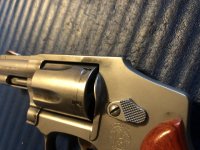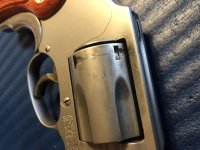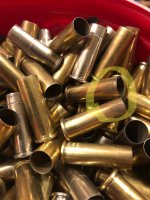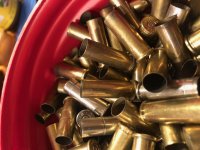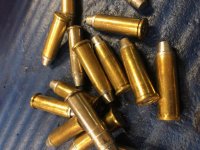What your seeing is pretty typical for lead/lubed bullets using standard 38spl/pressure loads. The fired cases look good, but I'd adjust your seating die so that:
The bullet isn't seated as deep, some of your loads rounds show the brass's top lip on the shoulder of the bullet. Use more crimp, it will increase the short start pressure of your load. Along with making it more consistent.
A picture of a s&w 686 6" bbl'd revolver after a 200 round range session.
The 200 rounds were cast/coated 158gr fn hp's (flat nosed hollow point) with a 3.3gr load of bullseye.
You can click on the picture above and save it. Then open it in any photo software on your computer and enlarge it. You will see that even though I'm using a coated bullet there's still powder fouling on the cylinder. On my revolver it's heavy on the front on the cylinder and migrates to the back of the cylinder & frame.
This is caused by the cylinder gap/bullet jump and the gasses that escape in that opening. All revolvers do this.
Why is yours heavier in the rear of the cylinder????
It has to do with where the front shoulder of the bullet sits in the throats of the cylinder. And the short start pressure of your load. A picture of a cut-a-way of a cylinder with the same bullet being seat short and then with a longer oal.
The bottom/longer oal puts the shoulder of the bullet out further into the leade of the cylinder. Doing this aids in increasing the short start pressure of your load. Along with sealing the cylinder by expanding the brass quicker. Right now your bullet is free boring/jumping that gap (same as jumping the cylinder gap) allowing gases to escape.
Back in the day we'd bring 30cal ammo cans full of cast bullet loads lubed with the old nra 50/50 lube to the range. After 200/300 rounds you'd have to wipe the revolvers down from all the soot/layers of half burnt lube on everything. And yes, the hands got washed also.
